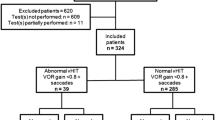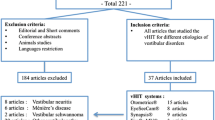Abstract
To evaluate the performance of the video head impulse test (VHIT) in assessing vestibular deficit in vestibular neuritis. Test validation study was conducted in Tertiary referral center. Twenty-nine patients, referred for vestibular neuritis between October 2009 and March 2012, were included. We recorded age, gender, values of caloric deficit (caloric testing), and deficits in semicircular function (VHIT) at initial presentation and at the follow-up visit (1–3 months). Multivariate linear regression analysis was performed to determine variables associated with values of caloric testing at the follow-up visit. Diagnostic values of VHIT were compared with caloric testing data using the receiver-operating characteristic (ROC) curve and subsequent statistical analysis. At the follow-up visit, complete recovery occurred in 31 % of cases according to caloric evaluation, and VHIT normalized in 51.8 %. Multivariate regression showed that a higher caloric deficit at the follow-up visit was associated with elevated age (p = 0.012) and high caloric deficit at initial presentation (p = 0.042). A lower caloric deficit was associated with normal VHIT results at the follow-up visit (p < 0.001). The ROC curve showed that specificity and sensitivity of VHIT were 100 % when the caloric deficit was respectively lower than 40 % or higher than 62.5 %. At the caloric testing value of 30 %, specificity was 100 %, sensitivity 68.84 %, positive predictive value 100 % and negative predictive value 62.5 %. VHIT is a fast, convenient and specific test to detect vestibular deficits in vestibular neuritis. However, VHIT lacks sensitivity by comparison with caloric testing, especially for moderate vestibular lesions.


Similar content being viewed by others
References
Strupp M, Brandt T (2009) Vestibular neuritis. Semin Neurol 29:509–519
Arbusow V, Schulz P, Strupp M et al (1999) Distribution of herpes simplex virus type 1 in human geniculate and vestibular ganglia: implications for vestibular neuritis. Ann Neurol 46:416–419
Aw ST, Fetter M, Cremer PD et al (2001) Individual semicircular canal function in superior and inferior vestibular neuritis. Neurology 57:768–774
Karlberg M, Annertz M, Magnusson M (2004) Acute vestibular neuritis visualized by 3-T magnetic resonance imaging with high-dose gadolinium. Arch Otolaryngol Head Neck Surg 130:229–232
Kim JS, Kim HJ (2012) Inferior vestibular neuritis. J Neurol 259:1553–1560
Halmagyi GM, Weber KP, Curthoys IS (2010) Vestibular function after acute vestibular neuritis. Restor Neurol Neurosci 28:37–46
Herzog N, Allum JH, Probst R (1997) Follow-up of caloric test response after acute peripheral vestibular dysfunction. HNO 45:123–127
Aw ST, Haslwanter T, Fetter M et al (1998) Contribution of the vertical semicircular canals to the caloric nystagmus. Acta Otolaryngol 118:618–627
Halmagyi GM, Curthoys IS, Cremer P et al (1990) Head impulses after unilateral vestibular deafferentation validate Ewald’s second law. J Vestib Res 1:187–197
MacDougall HG, Weber KP, McGarvie LA et al (2009) The video head impulse test: diagnostic accuracy in peripheral vestibulopathy. Neurology 73:1134–1141
Park HJ, Migliaccio AA, Della Santina CC et al (2005) Search-coil head-thrust and caloric tests in Meniere’s disease. Acta Otolaryngol 125:852–857
Perez N, Rama-Lopez J (2003) Head-impulse and caloric tests in patients with dizziness. Otol Neurotol 24:913–917
Schmid-Priscoveanu A, Bohmer A, Obzina H et al (2001) Caloric and search-coil head-impulse testing in patients after vestibular neuritis. J Assoc Res Otolaryngol 2:72–78
Reiss M, Reiss G (2012) Vestibular neuritis: is there any evidence of an asymmetric distribution? Eur Arch Otorhinolaryngol 269:1091–1094
Magnusson M, Karlberg K, Halmagyi M et al (2002) The video-impulse test enhances the possibility of detecting vestibular lesions. J Vestib Res 11:231
Ulmer E, Chays A (2005) Head impulse test de curthoys & halmagyi: un dispositif d’analyse. Annales d’Otolaryngologie et de Chirurgie Cervico-Faciale 122:84–90
Ishikawa K, Edo M, Togawa K (1993) Clinical observation of 32 cases of vestibular neuronitis. Acta Otolaryngol Suppl 503:13–15
Karlberg ML, Magnusson M (2011) Treatment of acute vestibular neuronitis with glucocorticoids. Otol Neurotol 32:1140–1143
Okinaka Y, Sekitani T, Okazaki H et al (1993) Progress of caloric response of vestibular neuronitis. Acta Otolaryngol Suppl 503:18–22
Magliulo G, Gagliardi S, Ciniglio Appiani M et al (2012) Selective vestibular neurolabyrinthitis of the lateral and superior semicircular canal ampulla and ampullary nerves. Ann Otol Rhinol Laryngol 121:640–644
Aw ST, Halmagyi GM, Pohl DV et al (1995) Compensation of the human vertical vestibulo-ocular reflex following occlusion of one vertical semicircular canal is incomplete. Exp Brain Res 103:471–475
Foster CA, Foster BD, Spindler J et al (1994) Functional loss of the horizontal doll’s eye reflex following unilateral vestibular lesions. Laryngoscope 104:473–478
Barmack NH (1988) The influence of temporary blockage of semicircular canals on the loss and recovery of vestibuloocular reflexes. J Neurosci 8:2816–2826
Barmack NH, Pettorossi VE (1988) The induction and compensation of asymmetric eye movements following unilateral blockage of a horizontal semicircular canal in the rabbit. J Neurosci 8:2836–2843
Paige GD (1983) Vestibuloocular reflex and its interactions with visual following mechanisms in the squirrel monkey. II. Response characteristics and plasticity following unilateral inactivation of horizontal canal. J Neurophysiol 49:152–168
Paige GD (1983) Vestibuloocular reflex and its interactions with visual following mechanisms in the squirrel monkey. I. Response characteristics in normal animals. J Neurophysiol 49:134–151
Shepard NT, Telian SA, Smith-Wheelock M (1990) Habituation and balance retraining therapy. A retrospective review. Neurol Clin 8:459–475
Tsuji K, Velazquez-Villasenor L, Rauch SD et al (2000) Temporal bone studies of the human peripheral vestibular system. Meniere’s disease. Ann Otol Rhinol Laryngol Suppl 181:26–31
Nadol JB Jr (1995) Vestibular neuritis. Otolaryngol Head Neck Surg 112:162–172
Schuknecht HF, Kitamura K (1981) Second Louis H. Clerf Lecture. Vestibular neuritis. Ann Otol Rhinol Laryngol Suppl 90:1–19
Conflict of interest
The authors have no conflict of interest to disclose.
Author information
Authors and Affiliations
Corresponding author
Rights and permissions
About this article
Cite this article
Bartolomeo, M., Biboulet, R., Pierre, G. et al. Value of the video head impulse test in assessing vestibular deficits following vestibular neuritis. Eur Arch Otorhinolaryngol 271, 681–688 (2014). https://doi.org/10.1007/s00405-013-2451-y
Received:
Accepted:
Published:
Issue Date:
DOI: https://doi.org/10.1007/s00405-013-2451-y




